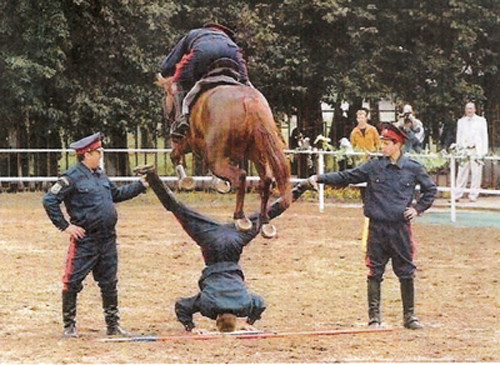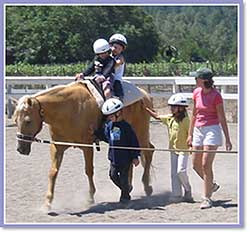Yesterday I talked about the importance of regularly replacing your helmet since the protective materials degrade over time. Today, I'm going to address the issue of safety testing.
Once you've made the decision to buy a new helmet, you probably want to know which helmets offer the most protection. An absolute answer is harder to come by than you might think because in the U.S. helmets are rated using a pass/fail system. Approved helmets meet the minimum requirements of the standard established by the American Society of Testing & Materials, ASTM F1163. This standard defines performance criteria and test methods.
Conformity assessment of riding helmets to defined standards is performed primarily by the Safety Equipment Institute (SEI). Helmet manufacturers provide samples of each model and size to the SEI for simulated crash testing using the methods defined in the ASTM Standard. SEI then publishes the models and sizes that pass the tests.
The video below demonstrates some of the testing that is performed on helmets and demonstrates very clearly how much better today's ASTM approved helmets protect your head than helmets of the past. They use a Caliente for comparison. I can vividly remember when I -- and many eventers -- wore a Caliente helmet because we thought that they were safer because they were favored by jockeys!
No comparative data is available.
So the question becomes, given that the cost of an ASTM helmet ranges from about $40 to more than $500, what do you get for the additional $450?
According to the Equestrian Medical Association:
"There is no evidence that higher priced helmets or those which use exotic materials test better than the other certified models. We don’t do comparison testing in the U.S. because one model will absorb more impact better than another on one impact site and then it may absorb less at another site. Without knowing where an individual head is going to be impacted, there is no fair way to say that any one model is superior.
The Safety Equipment Institute and the manufacturer receive test result numbers, and unless the manufacturer releases them to someone, they are considered to be proprietary information. Over the years some manufacturers have shared their information and from that limited data it appears that the least expensive sports helmets test the best; but all of the helmets on the certified product list exceed the minimum standards. . . . A larger liner means a larger helmet, which not only absorbs energy but which also works to deflect blows to the face, an uncovered area which is a frequent recipient of an impact."
In other words, fashion and trendiness seems to influence price more than actual performance. In fact, fashion may work against performance because according to the statement above, the helmets that will provide the best protection are probably the ones that are the least fashionable because they will not be the low profile, sleeker models, but rather the ones that make you look like a mushroom head.
In the U.K. there was an effort to publish independent helmet testing under the Equestrian New Helmet Assessment Program (ENHAP). The initiative was spearheaded by the Mark Davies Injured Riders Fund (named after a rider who died at the Burghley Horse Trials) and managed by the Transport Research Laboratory which is experienced in the testing of hats and which developed a new helmet system for Formula 1 racing. The group spent two years developing its test protocols and then published its assessment of 55 helmets that were already approved by EN, BS, ASTM or SNELL. The ENHAP tests included impacts on flat, curved and sharp surfaces as well as crush and stability tests.
Forty of the 55 helmets were rejected as being not safe enough.
The results published in 2003 were widely disputed by the major helmet manufactures and the British Horse Association. They were never updated and the report was pulled from the MDIRF web site. Incidentally, the US helmet manufacturer with the best scores was also the least expensive: Troxel.
The other interesting piece of information that came out of that study (and which I've seen confirmed elsewhere) is that smaller sized helmets performed better than larger ones. So, if you have a larger head, you are already at a disadvantage!
The bottom line? Find an ASTM/SEI approved helmet that fits you well (there are now helmets for almost every shape of head) and most importantly, wear it!
Air vests for Riding; I've seen it work!
I have seen the Hit Air bag work two different times to save riders from being injured in a fall.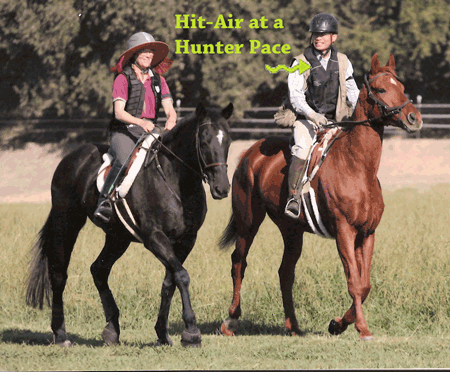
I have clients who want to ride cross country, jumping obstacles. I was watching from my own horse as my student cantered toward a jump in a large 100 acre field. He cantered about 50 yards across the field and turned back toward me to jump a practice fence. My horse turned his head as if to walk; I looked down at him and as i turned his head back--I heard an unfamiliar sound. When I looked up, my client was standing on the ground holding his horses empty bridle and;his horse was running across the field bridleless.
Approaching the jump, his horse propped his front legs causing my client to fly off over the top of his horses head. In that instant I had looked down, the fall had happened; the air bag had deployed, and my client was standing and unharmed before I realized what happened. I rode to him, he was laughing and saying "It worked, it worked", talking about his vest. The next day we rode together in this hunter pace. He is wearing his vest in the picture.
The second time I saw the vest work, a client was practicing one-rein stops while riding a hot arab horse. As well as riding english, we integrate other methods. I had other riders in the arena. As I worked with another rider, I head an unfamiliar noise behind me. Another rider said, "ut,oh". I turned my head and saw the arab's rider on the ground. The horse had stumbled, she tipped forward, lost her balance and fell to the ground over the horses shoulder.
 In his attempt to not fall with her, the horse stepped on her as well. She had no injuries or bruising where the vest was, but later had bad bruising on her inner thigh and imprints of the horses foot. The vest protected her body when she fell, and if she had been stepped on where the vest was, there was no bruising or traces of impact. I am recommending these vest to all my clients.
In his attempt to not fall with her, the horse stepped on her as well. She had no injuries or bruising where the vest was, but later had bad bruising on her inner thigh and imprints of the horses foot. The vest protected her body when she fell, and if she had been stepped on where the vest was, there was no bruising or traces of impact. I am recommending these vest to all my clients.
Hit Air - Airbag Vests and Jackets Not just for the Professional!!
I finially had an incident that set off my own safety vest. An older unbroke mustang bolted out of the arena. He hesitated at a fence like he might jump over it or spin and continue running. I took this opportunity to jump off as quickly as i could. When my feet hit the ground I was still standing. My vest is set so that I can dismount without deploying it. In this instance, my feet slipped on the gravel and went out from under me. Before my seat hit the ground the air bag was snug around my neck, torso, and tail bone. I only got a tiny bruise where I rolled sideways onto my hip. As for the horse, he spun and continued running, but i was safe!
http://www.iatselocalone.org/safety/Sineonov.pdf
http://www.youtube.com/watch?v=9ESXNDIeDV4
http://www.youtube.com/watch?v=-7oM9hOqjqM&NR=1
Check this out, Prelim rider with helmet cam and hit air vest! http://www.youtube.com/watch?v=TymB8EbEZqc
Keeping Yourself Safe When Riding
and article in the magazine The Horse, http://www.thehorse.com//ViewArticle.aspx?ID=17093&eID=309733
Article from University of Kentucky on Safety!
Safety OOPs of the Moment, think a head..
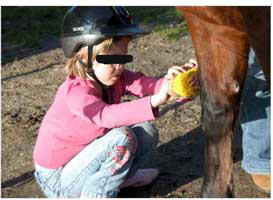 |
 |
| Ooops, what if..... the horse spooks forward? What if the horse accidentally steps on this child's belly, or face, or pelvis? This was taken from an ad for a therapeutic riding program. Some of this horror is bad photography, the angle makes it appear as if the little human is in front of both of the horse's front legs, but Gee, it is only in front of one side of the horse. That really increases the safety odds..... | With ads like this, is it any wonder children don't understand that wearing a helmet is necessary. I am appalled that a magazine trying to sell horse products would be so careless about lack of horse safety. No reins, no helmet. What if the horse got stung by a bee? |
What were they thinking?????? |
This was an email solicitation for donations or a marketing ad sent from a a california NRHA certified riding program. This tells us something about the education involved in some certification programs. Then again, if the child is already disabled.... This picture should scare everyone to death. Riding double, walking beside a horse whose head is not controlled ups the ods of gtting kicked, stepped on. Just stupid, and careless. This is just PURE IGNORANCE. |
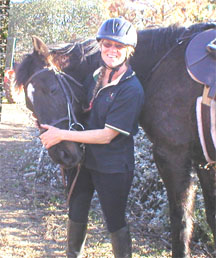 Me and BootZ
Me and BootZ 

